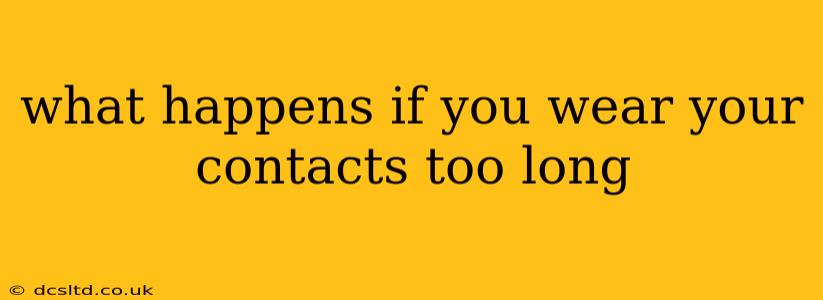What Happens If You Wear Your Contacts Too Long? The Risks of Extended Wear
Wearing contact lenses for extended periods beyond what your eye doctor recommends can lead to a range of serious eye problems. Understanding these risks is crucial for maintaining the health of your eyes. This article will explore the potential consequences of wearing contacts for too long, addressing common concerns and providing valuable information to help you make informed decisions about your eye care.
What are the recommended wearing schedules for contact lenses?
The recommended wearing schedule for contact lenses varies greatly depending on the type of lens. Disposable contacts, such as daily disposables, are designed for single-day use and should never be worn overnight. Extended-wear contacts, specifically designed for overnight wear, still have limitations and should be followed precisely as prescribed by your eye doctor. Conventional contacts (those that are cleaned and reused) usually have a recommended wearing schedule that involves removing them at night. Never deviate from your ophthalmologist's instructions without consulting them first.
Can wearing contacts too long cause blurry vision?
Yes, extended wear can certainly cause blurry vision. This is often an early symptom of issues like corneal edema (swelling of the cornea), which can significantly impair vision. Prolonged exposure to contact lenses can also lead to dryness, irritation, and decreased oxygen supply to the cornea, all resulting in reduced visual acuity.
What are the risks of sleeping in your contacts?
Sleeping in your contacts, even if they're designed for extended wear, significantly increases your risk of several eye infections and complications. The most serious is microbial keratitis, a corneal infection that can cause severe pain, vision loss, and even permanent blindness. Other potential risks include:
- Giant papillary conjunctivitis (GPC): This condition causes inflammation and the growth of large papillae on the conjunctiva, leading to discomfort and blurry vision.
- Corneal ulcers: These are open sores on the cornea that can result from infection or damage.
- Hypersensitivity: Prolonged contact with the lens can trigger allergic reactions in sensitive individuals.
Can prolonged contact lens wear lead to permanent damage?
While many of the issues associated with wearing contacts too long are reversible with proper treatment, there is a risk of permanent damage if the condition is left untreated. Severe corneal infections, for example, can lead to scarring, vision loss, and even the need for corneal transplant surgery. The longer you wear your lenses beyond the recommended timeframe, the greater the risk of irreversible damage.
What are the signs I should remove my contacts immediately?
If you experience any of the following symptoms, remove your contact lenses immediately and contact your eye doctor:
- Severe eye pain
- Redness and swelling
- Excessive tearing
- Blurred vision
- Increased sensitivity to light
- Discharge or pus
- Feeling of something in your eye
How often should I see my eye doctor for contact lens checkups?
Regular checkups with your eye doctor are paramount, regardless of the type of contact lenses you wear. These checkups allow for monitoring of your eye health, ensuring the lenses still fit properly, and detecting potential problems early on. Your eye doctor will advise on the frequency of these appointments based on your individual needs and the type of lenses you use. Don't skip these important visits; your eye health depends on it.
In conclusion, adhering to your eye doctor’s recommendations regarding contact lens wear is crucial for maintaining the health of your eyes. Ignoring these guidelines can lead to a range of serious complications, some potentially irreversible. Prioritizing proper contact lens hygiene and regular eye examinations is vital for preventing eye problems and ensuring clear, comfortable vision.
